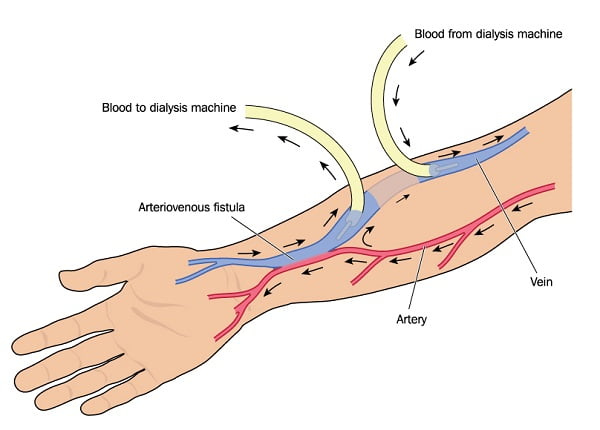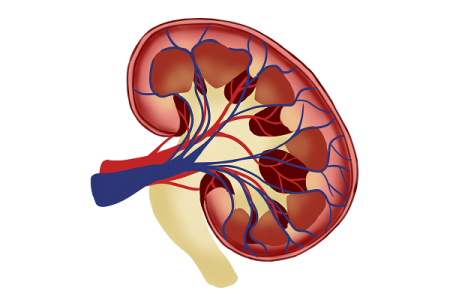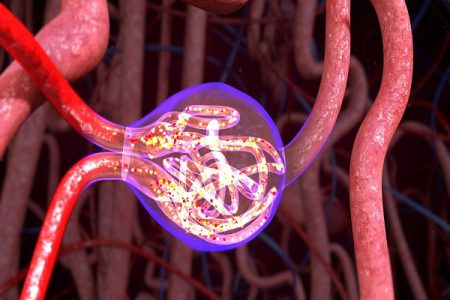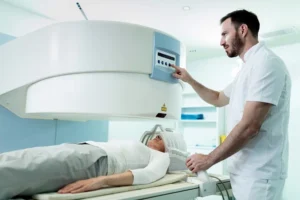Dialysis: Procedure and Benefits
- Updated on: Jun 10, 2024
- 4 min Read
- Published on Apr 19, 2021


What is dialysis?
Humans have two kidneys, each about the size of a fist, and located on either side of your spine. Kidneys help in purifying the blood by removing waste and excess fluid from the body. If the function of kidneys is disturbed, dialysis is used to perform their function.
Dialysis is a treatment that is generally given in case of chronic kidney disease and kidney failure which helps filter and purify the blood with the help of a machine. This helps your body in balance and the function of the kidneys can be performed through artificial ways.
Dialysis was first used in the 1940s to treat people with kidney problems.
Why is dialysis used?
The function of kidneys is to prevent extra water and waste from collecting in the body. They also help control blood pressure and regulate the levels of chemicals in the blood, such as sodium and potassium.
If the kidneys stop performing the way they are expected to work, dialysis is used to help keep the body running normally. It is important to know that dialysis isn’t a cure for kidney disease or other problems. This is just to compensate due to non-functioning or improper functioning of the kidneys. As long as dialysis goes on, the body works fine. As you stop the dialysis, the wastes start accumulating again.
How does dialysis Work?
Dialysis removes waste particles and fluids from your body that your kidneys are unable to remove due to their not functioning properly. Another objective of dialysis is to keep your body in balance by correcting the levels of various toxic substances in the blood.
If dialysis is not performed, patients with complete kidney failure would die from the accumulation of toxins in their bloodstream.
A semi-permeable membrane is used to separate the blood from the dialysis fluid. This membrane allows some substances to pass through, but not others causing the unwanted wastes to be filtered out.
The waste products, water, electrolytes and other substances are removed from the blood into the dialysis fluid through the process of diffusion. Membrane’s permeability, its size and structure of the various substances present in the blood, dialysis fluid, and the blood supply to the membrane, all define the movement of waste products and other substances.
The better the blood supply to the membrane, the better is the dialysis treatment. Blood supply can be controlled by the dialysis machine in a haemodialysis technique.
Dialysis fluid contains substances which help to correct imbalances as a result of kidney failure or chronic kidney disease.
How does dialysis clean my blood?
Dialysis is done through dialyzer, a type of filter which has two parts, one for your blood and another for the dialysis fluid called dialysate. The thin membrane separates these two parts. Blood cells, protein and other important things that your body need remain in the blood because they are big and not able to pass through the membrane. Smaller particles in the blood, such as creatinine, potassium, urea, and other undesirable fluids or particles pass through the membrane and are drained away.
Principles of dialysis
There are two ways of doing dialysis, as discussed here.
Hemodialysis: Hemodialysis is the most common way of performing dialysis. It uses an artificial kidney, called hemodialyzer, to remove waste undesirable products and chemicals from the blood. A doctor creates a vascular access into your blood vessels surgically to make an entry into the body. This allows the blood to flow through your body during hemodialysis treatment for filtration and purification.
Peritoneal Dialysis: Peritoneal dialysis involves implanting a catheter into your belly area surgically. The procedure involves passing a fluid called dialysate into your abdomen. The dialysate draws waste out of the bloodstream. It is then drained out from the abdomen.
How long each hemodialysis treatment last and how often do I need them?
In a hospital or a dialysis center, hemodialysis is usually done 3 times per week. Each time, it takes about 4 hours. People can choose to do hemodialysis at home. They can do it more often, about 4-7 times per week for shorter duration each time.
Can I do hemodialysis at home?
Yes, you can do it at home. Many patients do their hemodialysis at home.
FAQs
How long does a dialysis session usually last?
Hemodialysis sessions typically last about 3-4 hours, while peritoneal dialysis may involve longer overnight sessions.
What are the benefits of peritoneal dialysis over hemodialysis?
Peritoneal dialysis offers more flexibility and can be done at home, providing greater independence for some patients.
Is dialysis painful?
The procedure itself is not painful, but some patients may experience discomfort or cramps during or after the session.
Can a person lead a normal life while on dialysis?
With proper management, many individuals on dialysis lead fulfilling lives. However, lifestyle adjustments and adherence to treatment plans are essential.
Are there dietary restrictions during dialysis?
Yes, patients on dialysis often need to follow a special diet, including restrictions on sodium, potassium, and phosphorus intake.












